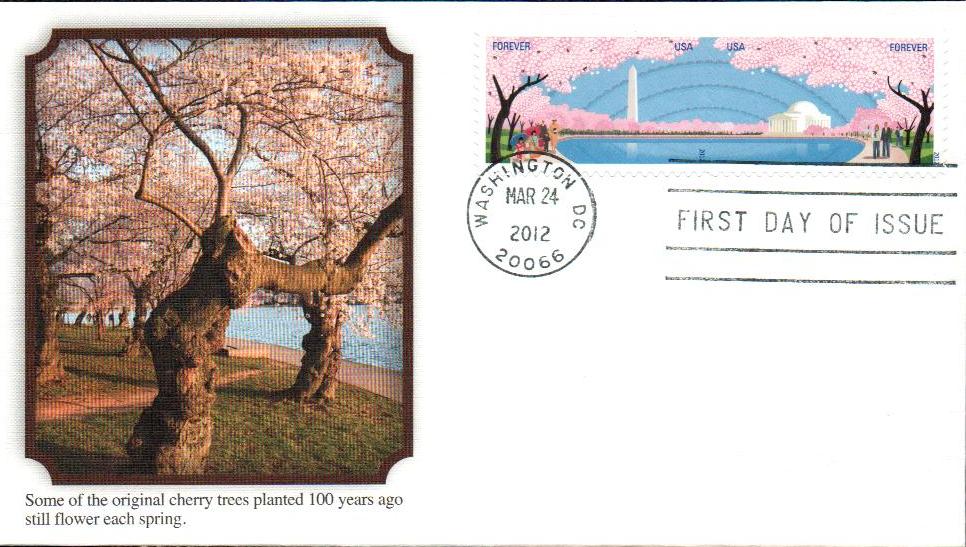
# 4651 - 2012 First-Class Forever Stamp - Cherry Blossom Centennial: Washington Monument
and Washington Monument
City: Washington, DC
Printed By: Ashton Potter
Printing Method: Offset
Color: multicolored
Cherry Trees Planted Along The Potomac

On March 27, 1912, US First Lady Helen Taft and wife of the Japanese ambassador Viscountess Chinda planted two Yoshina cherry trees on the northern bank of the Potomac River. The plantings were in celebration of the Japanese gift of 3,020 cherry trees to the US government.

The effort to bring cherry trees to the nation’s capital was headed by writer Eliza Scidmore (1856-1928). The flowering cherry tree, or “Sakura,” is a flowering plant symbolizing human life and transformation in Japanese culture. After returning from a trip to Japan in 1885, she imagined rows of trees along the shores of the Potomac River. Scidmore was raising money to buy trees to donate to the city when she wrote a letter to First Lady Helen Taft. Mrs. Taft was immediately in favor of the project.

Then in April 1909, Mrs. Taft discovered an area of swampland along the Potomac and was inspired to create a massive bandstand for the Marine Band to put on concerts twice a week. She tasked the Agriculture Department with bringing all available cherry blossom trees to the capital to be planted in a single row.

Working with the Office of Public Buildings and Grounds and the Japanese Embassy, Mrs. Taft arranged for the delivery of 2,000 trees from Japan. However, these trees were found to be infested with insects and burned. A new crop of over 3,000 trees was sent in 1912 and found to be in good condition.

On March 27, 1912, Mrs. Taft and the wife of the Japanese ambassador to the US planted the first two cherry trees. Those same trees continue to grow today. Over the years, Japan donated thousands of additional flowering cherry trees. In 1915, the US returned the favor, donating several flowering dogwood trees to the people of Japan.

These beautiful trees drew such a crowd over the years, an entire festival was conceived to celebrate them. The first Cherry Blossom Festival was held in 1934. It has continued every year, except during World War II. The three-day event has expanded to five weeks of activities for every interest. These include parades, street fairs, and cultural events.
and Washington Monument
City: Washington, DC
Printed By: Ashton Potter
Printing Method: Offset
Color: multicolored
Cherry Trees Planted Along The Potomac

On March 27, 1912, US First Lady Helen Taft and wife of the Japanese ambassador Viscountess Chinda planted two Yoshina cherry trees on the northern bank of the Potomac River. The plantings were in celebration of the Japanese gift of 3,020 cherry trees to the US government.

The effort to bring cherry trees to the nation’s capital was headed by writer Eliza Scidmore (1856-1928). The flowering cherry tree, or “Sakura,” is a flowering plant symbolizing human life and transformation in Japanese culture. After returning from a trip to Japan in 1885, she imagined rows of trees along the shores of the Potomac River. Scidmore was raising money to buy trees to donate to the city when she wrote a letter to First Lady Helen Taft. Mrs. Taft was immediately in favor of the project.

Then in April 1909, Mrs. Taft discovered an area of swampland along the Potomac and was inspired to create a massive bandstand for the Marine Band to put on concerts twice a week. She tasked the Agriculture Department with bringing all available cherry blossom trees to the capital to be planted in a single row.

Working with the Office of Public Buildings and Grounds and the Japanese Embassy, Mrs. Taft arranged for the delivery of 2,000 trees from Japan. However, these trees were found to be infested with insects and burned. A new crop of over 3,000 trees was sent in 1912 and found to be in good condition.

On March 27, 1912, Mrs. Taft and the wife of the Japanese ambassador to the US planted the first two cherry trees. Those same trees continue to grow today. Over the years, Japan donated thousands of additional flowering cherry trees. In 1915, the US returned the favor, donating several flowering dogwood trees to the people of Japan.

These beautiful trees drew such a crowd over the years, an entire festival was conceived to celebrate them. The first Cherry Blossom Festival was held in 1934. It has continued every year, except during World War II. The three-day event has expanded to five weeks of activities for every interest. These include parades, street fairs, and cultural events.







